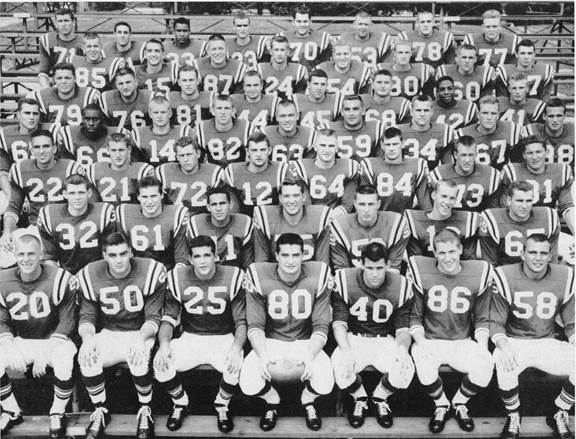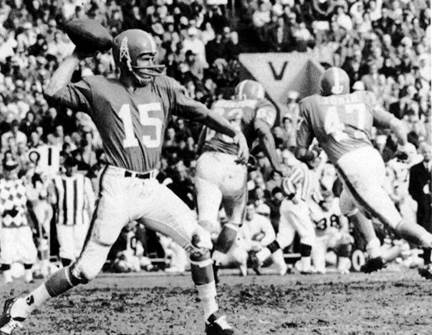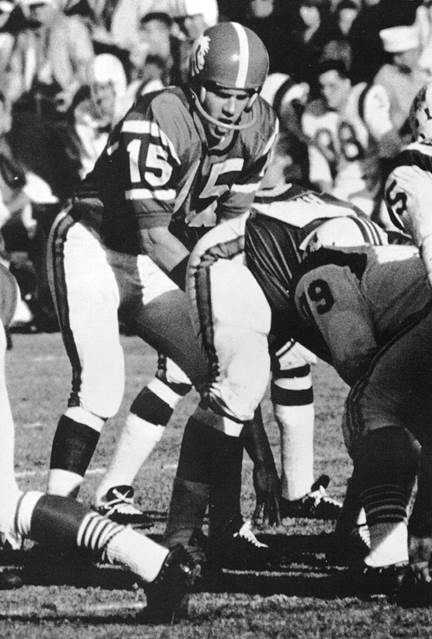

JACKY LEE, MORE THAN THE "LEND - LEASE QUARTERBACK"
HELMET HUT NEWS/REFLECTIONS March 1 2016:
JACKY LEE, MORE THAN THE
"LEND - LEASE QUARTERBACK"
By Dr. Ken
Jack Lee can call forth a host of distinctive memories related to a very good football career if he wishes. Unfortunately, he is best known for the distinction he cares little for and one that marks him as a “one and only” in the history of modern professional football. An All Akron, Ohio Metro area and All District pick at quarterback in his 1955 senior season at Ellet High School, the Orangemen’s substandard 2-6-1 record found him overlooked for the All Ohio High School teams dominated by Barberton’s future Notre Dame star quarterback George Izo. He departed Ellet as the school’s all-time scoring leader in basketball, best career stats as a hitter in baseball, and as the Orangemen’s all-time passing leader with a reputation as an excellent safety. Although he was a gifted athlete and would fill out to 6’1”, 190 pounds later in his career, his graduating stature of 6’ and a thin 168 made the University of Cincinnati his best college football choice. Lee was a solid performer for the 1956 frosh team and was the obvious stand-out in the spring game prior to his sophomore season. As much promise as Lee had, he would have to eclipse the play of the versatile Joe Morrison who entered the ’57 season as an All American candidate at quarterback and defensive halfback, and the All Missouri Valley Conference quarterback on the 1956 squad.
Morrison, whose collegiate and
professional careers were among
the most underrated in the
history of the game, had been
the Bearcats’ best player on
both sides of the ball, a track
squad sprinter, and described by
more than one pro scout as “the
finest prospect I saw this
spring.” In’57, Morrison was
again the first team All
Missouri Valley Conference
quarterback despite being
hobbled by a sprained ankle. The
injury allowed Lee to alternate
frequently and he proved to be
UC’s most effective passer in
years, putting up what was for
that era, big-time starter’s
numbers. Entering the 1958
season, Lee’s passing ability
was too obvious to overlook and
Morrison was moved to left
halfback while maintaining his
two-way playing status. This
resulted in Lee being named as
an Honorable Mention All
American and both Lee and
Morrison as first team All
Conference picks. Lee’s
statistics allowed him to crack
the national top ten passer
ratings.
 |
University of Cincinnati’s 1959 squad with Jacky Lee seated second from right in the second row.
“General” Jack Lee finished his Cincinnati career in style, again named as the 1959 All Missouri Valley quarterback, the Bearcats team MVP, and leaving six school passing records. Horrid weather limited the offense in a number of games, perhaps keeping Lee from being the top passer in the nation as he finished a close second to Stanford’s Dick Norman. He earned the MVP award in the 1960 Senior Bowl and became the Houston Oilers first round draft choice and the Chicago Cardinals sixth rounder. The Oilers staff visualized Lee as a back-up to long-time veteran George Blanda but even as a rookie, as he did during his first four seasons as an Oiler, he played in every game. He kicked his pro career off in great fashion, completing his first three touchdown passes for seventy-eight, ninety-two, and seventy-two yard strikes! Lee proved to be very effective at times, and demonstrated his great potential. Against the Boston Patriots in ’61, he completed twenty-seven passes for 457 yards, then an AFL record and set another league record with a ninety-eight yard touchdown strike to wide receiver (and first active NFL player to sign with the AFL) Willard Dewveall versus the Chargers.
 |
Lee appeared in every Oilers game from 1960 through 1963
Sports Illustrated called
Blanda and Lee “the best set
of quarterbacks in the AFL”
in 1962. Typical of the
three to four year
apprentice period that most
young quarterbacks went
through during the 1960’s,
Lee improved and believed he
was ready to take the reins
from Blanda, who began to
show some inconsistency. The
Houston brass must have felt
that Blanda would in fact
need more assistance in the
near future as they entered
1963 having drafted Baylor
quarterback Don Trull.
However, more important than
the development of young
quarterbacks, at least in
the eyes of American
Football League Commissioner
Joe Foss, was the ability to
maintain competitive balance
within the league and secure
the interest of the sporting
public. With the Denver
Broncos reeling with tenuous
ownership and a 1963 record
of 2-11-1, Foss had concerns
about the future of the
franchise. The Broncos saw
starting quarterback Frank
Tripuka retire after the
second game of the season,
finally worn down by his
previous fourteen years of
professional football. The
position was thrown open to
rookies Mickey Slaughter and
Don Breaux before signing
former Minnesota Vikings
back-up John McCormick.
Nothing helped as McCormick
succumbed to injury and the
constant shuffling of
Slaughter and Breaux
resulted in ten consecutive
losses to close the season.
Foss proposed a
first-and-last-time-in-history
plan to prop up the Broncos.
Entering the 1964 season,
the Oilers would receive a
first round draft choice and
defensive tackle Bud McFadin
from the Broncos in exchange
for quarterback Lee. The
“kicker” to this deal was
that Lee would not be traded
to the Broncos but instead,
given over for a two year
“lease” and then returned to
the Oilers. Houston was
reluctant to trade Lee,
knowing he was primed to
take over for Blanda. The
lend-lease provision allowed
Lee to play, develop, and be
returned to the Oilers at
the time Blanda was expected
to retire. Some believed
that the arrangement
cheapened the league;
“cognoscenti considered (the
AFL) a minor league anyway,
a deal like this gave the
appearance that the Broncos
were a farm team within it.”
Denver head coach Jack
Faulkner had been Lee’s
position coach at Cincinnati
and viewed it as a positive
and the displaced
quarterback reported to the
Broncos on August 14, 1964.
Decades later Lee noted, "I
had been working behind
George Blanda, but thought I
was about to get my chance
but Bud Adams told me I had
to go to Denver for two
years and then would come
back to Houston. I think
that's the only deal that
ever has been made that
way."
Lee calls signals for
the Broncos as their
leased quarterback

The arrangement did not
work out well for either
team. Lee finished the
’64 season with 133
completions in 265
attempts for 1611 yards
but his eleven touchdown
throws were more than
offset by twenty
interceptions. The
second consecutive
2-11-1 record found Mac
Speedie replacing
Faulkner in the head
coaching chair for the
1965 season, leaving Lee
with forty-four
completions for eighty
attempts. With no desire
to build his future
around a quarterback
whose lease would expire
at the end of the ’65
season, Speedie forced
Lee’s downward plunge to
third string behind
Slaughter and McCormick.
The Broncos would finish
at 4-10 and Lee was
returned to Houston for
the 1966 season. Blanda
of course was far from
retirement in ’66 and
instead of the
fulfillment of the
original plan to have
Lee return and take the
reins, he instead saw
very limited action as
he adapted to what was
now for him, a new team.
The Oilers did not play
well in ’66, finishing
the season with a 3-11
record which led to the
March 18, 1967 release
of Blanda. The
seemingly ageless
quarterback landed on
his feet with the
Oakland Raiders where he
would complete a
twenty-six year pro
career and Lee took over
the signal calling for
‘67. Not satisfied with
the early results, the
Oilers traded Lee,
underachieving defensive
tackle Ernie Ladd, and
1968’s first round draft
choice to the Chiefs on
October 9th.
In return they received
Chiefs’ back-up
quarterback Pete
Beathard who piloted the
Oilers to a surprising
9-4-1 record and Lee
became Len Dawson’s
back-up in Kansas City.